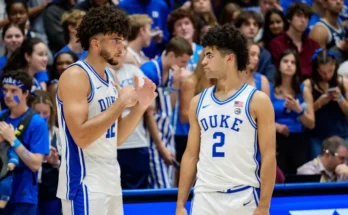Paul Finebaum Identifies the Team Likely to Return to the College Football Playoff
The College Football Playoff (CFP) has become the gold standard in determining college football’s national champion, a shift that’s elevated not only the prestige of the playoff but also the intensity and excitement surrounding the sport. The playoff was first introduced in the 2014 season, and since then, it has provided fans with some of the most dramatic and compelling games in recent memory. Year in and year out, certain programs stand out as consistent contenders, but with new teams making their marks, the landscape of college football is always shifting.
Paul Finebaum, ESPN’s leading college football analyst and host of *The Paul Finebaum Show*, is one of the most respected voices in the sport. His insights into the intricacies of college football come from years of experience covering the game. In recent years, Finebaum has not only offered opinions on the teams making waves but also identified which teams are most likely to return to the CFP. His analysis is a mixture of tradition, player development, recruiting prowess, coaching continuity, and national recognition—each factor playing a vital role in determining a team’s potential for future success.
#### 1. **The Powerhouses: Alabama and Georgia**
Historically, two of the most dominant programs in college football are Alabama and Georgia. Alabama has been a perennial contender since Nick Saban took over as head coach in 2007. Under his leadership, the Crimson Tide has consistently fielded championship-caliber teams, winning multiple national titles and almost always contending for the top spot. Finebaum, who has been closely tied to Alabama football for decades, has pointed out that the Crimson Tide is likely to continue being a CFP fixture for the foreseeable future. Saban’s recruiting classes are consistently among the best in the nation, and the program’s culture of excellence is unmatched.
However, in recent years, Alabama has faced more challenges, especially from Georgia, who has emerged as its biggest threat in the SEC. Georgia’s rise under head coach Kirby Smart has been meteoric, with the Bulldogs securing the 2021 national championship and continuously recruiting top-tier talent. Finebaum has acknowledged that Georgia’s trajectory is one that suggests a return to the CFP is not just a possibility, but an expectation. The Bulldogs are well-positioned to be regular playoff contenders, thanks to their combination of elite defense, dynamic playmaking on offense, and Smart’s ability to sustain a championship-winning culture.
Both Alabama and Georgia, by virtue of their sustained success, remain the most likely candidates to return to the College Football Playoff in the near future. Finebaum’s analysis has consistently pointed out that both programs possess the necessary ingredients for long-term success—strong coaching staffs, elite players, and top-notch recruiting pipelines.
#### 2. **Clemson: The Slip and the Potential for a Comeback**
For many years, Clemson was an automatic selection in the CFP. Under Dabo Swinney, the Tigers won two national championships (2016 and 2018) and became the standard-bearer for ACC football. However, the 2020s brought about some challenges for Clemson, and the program has faced a period of transition. Despite still being a strong contender, the Tigers fell short of making the CFP in recent years. Finebaum has noted that Clemson’s inability to keep up with teams like Alabama, Georgia, and Ohio State, especially in terms of quarterback play, has been a critical factor in their slip from the top.
However, Finebaum also identifies Clemson as a potential contender to return to the College Football Playoff soon. Swinney’s ability to recruit at a high level and develop talent has not diminished, and if the Tigers can find stability at the quarterback position, they could easily make a return to the CFP. Finebaum’s insights suggest that with the proper adjustments—particularly in terms of developing a more dynamic offense and improving quarterback play—Clemson could be right back in the playoff picture within a few years.
#### 3. **Ohio State: The Consistency Factor**
One of the most consistently successful programs in college football over the past decade has been Ohio State. Since Urban Meyer took over the program in 2012 and handed it over to Ryan Day in 2019, the Buckeyes have remained at the top of the college football hierarchy. Ohio State has made multiple appearances in the College Football Playoff and is a constant contender for the Big Ten championship.
Paul Finebaum has frequently noted that Ohio State’s mix of excellent recruiting, coaching, and player development puts the program in an excellent position to continue its CFP appearances. Even though they fell short in 2022, the Buckeyes have a talent pool and infrastructure that is difficult for other programs to match. Additionally, Day’s offensive schemes and ability to develop quarterbacks (such as Justin Fields and C.J. Stroud) make Ohio State an almost automatic contender for the playoff.
Finebaum has pointed out that Ohio State’s consistent success is also due to its national recruiting base, which has allowed the Buckeyes to acquire top-tier talent from across the country. Ohio State’s location, combined with its resources and history of success, makes it a perennial power in college football. Finebaum sees Ohio State as another team that will continue to return to the College Football Playoff in the coming seasons, barring unforeseen challenges.
#### 4. **Michigan: The Resurgence**
Michigan’s resurgence under head coach Jim Harbaugh has been one of the most interesting storylines in college football over the past few seasons. After years of mediocrity and underachievement, Harbaugh and the Wolverines returned to prominence in 2021, winning the Big Ten Championship and earning a spot in the CFP. Michigan followed up with another strong season in 2022, further cementing its status as one of the top programs in the country.
Finebaum has lauded Michigan’s improvement, highlighting Harbaugh’s ability to adapt and evolve, particularly in terms of his offensive philosophy. Michigan’s success has been largely built on a strong, balanced team with an emphasis on a powerful running game and a well-coached defense. While the Wolverines have faced some challenges in terms of quarterback play and recruiting, Finebaum believes that Michigan’s overall trajectory points to continued success. The program’s ability to compete in a strong Big Ten and its recent results indicate that Michigan could be a team to watch for future CFP appearances.
#### 5. **The Wild Cards: Programs on the Rise**
Beyond the established powers, Finebaum also identifies several teams on the rise that could break into the College Football Playoff picture in the near future. These programs may not have the same level of consistency as Alabama or Ohio State, but their recruiting, coaching, and development make them potential playoff teams.
One such program is USC, which has been revitalized under Lincoln Riley. With an offense built around quarterback Caleb Williams and a growing recruiting class, USC is poised to make a run at the CFP. Finebaum has mentioned the Trojans as a program with significant potential, especially if they can improve defensively.
Another program to watch is Texas, which has long been a sleeping giant in college football. With the hiring of Steve Sarkisian and a strong recruiting class, Texas appears to be on the cusp of returning to national prominence. Finebaum has suggested that Texas is a team to watch, particularly as the Longhorns prepare to join the SEC, which will provide them with even more challenges but also opportunities for growth.
Finally, Florida State is a program that Finebaum sees as a possible dark horse for the College Football Playoff. The Seminoles have been steadily improving under head coach Mike Norvell, and Finebaum has pointed out that their recent success, combined with strong recruiting, puts them in a favorable position moving forward.
#### 6. **The Changing Landscape: CFP Expansion**
One of the most significant changes in recent years is the announcement that the College Football Playoff will expand from four teams to 12 teams in the near future. This shift will allow more teams to compete for a national championship, and Finebaum has noted that this could open up opportunities for programs outside the traditional powerhouses to make their mark. While Alabama, Georgia, Ohio State, and other top programs will likely remain contenders, the expanded playoff format means that teams from conferences like the Pac-12, Big 12, and ACC will have a better shot at earning a spot in the playoff.
Finebaum has emphasized that the expanded playoff will make the sport more inclusive, but it will also increase the pressure on teams to perform consistently at a high level. With more teams vying for a spot, it will be essential for programs to not only build strong rosters but also maintain the infrastructure and culture necessary to succeed.
As Paul Finebaum analyzes the future of the College Football Playoff, it’s clear that certain teams are more likely than others to continue their dominance in the coming years. Alabama, Georgia, Ohio State, and Clemson are all expected to remain staples of the playoff, but other programs like Michigan, USC, and Texas are also on the rise.
The changing dynamics of college football, particularly with the impending CFP expansion, mean that the landscape of the sport is ever-evolving. While Finebaum’s analysis points to these traditional and emerging powerhouses as the most likely teams to return to the College Football Playoff, the future remains exciting and full of possibility.



